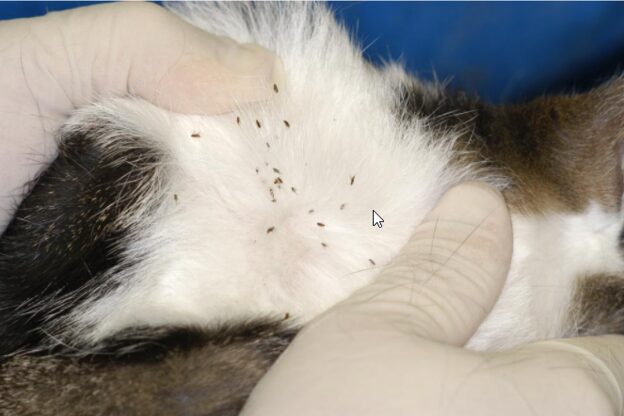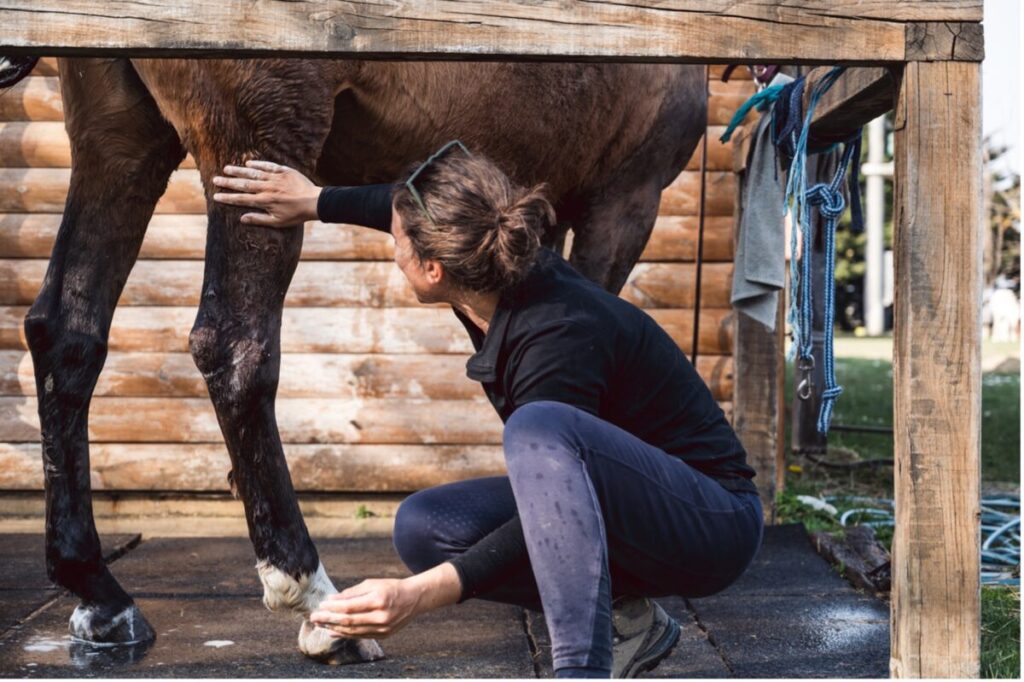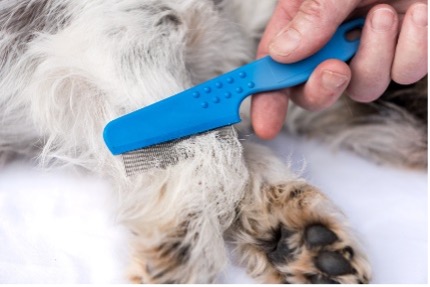Welcome to our comprehensive flea and tick prevention guide for Cats, Dogs, Exotic Pets, and Horses. Ticks and fleas aren’t just annoying; they can pose serious health risks to your beloved pets. In this article, you will learn how to recognize the signs of infestation and learn about effective prevention and treatment methods. Let’s dive in!
Flea and Tick Prevention Begins with Recognizing the Problem
Ticks and fleas are nasty pests that can live in your pet’s fur and bite it to feed on its blood. One of the scariest things about them is that they can each potentially transmit disease to your pet. To successfully manage these pests, you need to know what the different pests look like and how to recognize when your pet has an infestation.
Recognizing a Tick Problem:

There are many varieties of ticks. Ticks found in Oklahoma include:
- American Dog Tick
- Lone Star Tick
- Brown Dog Tick
- Black Legged Tick (also called deer tick)
- Winter Tick
- Gulf Coast Tick
- Fowl Tick (Tick found on poultry)
- Spinose Ear Tick (common on horses, cattle, and other wild and domestic animals)
Symptoms of a possible infestation:
Licking or chewing: Your pet may lick or chew at the spot on their body where the tick is attached.
Inflamed skin: The skin around where the tick is attached will become red and inflamed.
Anemia (not enough red blood cells): Anemia may occur if your pet has multiple ticks, leading to excessive blood loss and resulting in pale gums and lethargy.
List of Common Tick-Born Diseases that Can Affect Animals
- Lyme Disease
- Ehrlichiosis
- Anaplasmosis
- Rocky Mountain Spotted Fever
- Babesiosis
- Hepatozoonosis
- Tick Paralysis
These diseases can vary in severity and clinical signs, and some may have overlapping symptoms. In many cases, symptoms increase with time and result in pain and long-term disability. Seeking medical evaluation and early treatment are essential and can lead to resolving the disease. Untreated infections can result in permanent disability or, in some cases, death.
Pet owners must be vigilant about tick prevention and promptly remove any ticks found on their pets or have a professional remove them to reduce the risk of these diseases. Ticks infected with serious diseases do not usually transmit those pathogens immediately and often must feed for a period of time before disease transmission. Hence, removing ticks as soon as possible is critical.
The article Common Ticks of Oklahoma and Tick-borne Diseases from Oklahoma State University contains more information about ticks and tick diseases in Oklahoma.
Recognizing a Flea Problem
 Photo Courtesy of Dr. Michael W. Dryden
Photo Courtesy of Dr. Michael W. Dryden
Some people think that a few fleas on their pet will not harm their pet. However, a pet can suffer from an allergic reaction from just one single flea bite. Additionally, fleas reproduce quickly and abundantly. A female lays up to 50 eggs per day! Here are some signs that can help you spot a flea problem:
- Excessive scratching or biting at their skin: Your pet will scratch and bite at the spot where the flea bites them. Not only can a flea’s bite be painful, but they also excrete a substance that causes irritation and itching.
- Flea “dirt”: Flea dirt is flea poop! When fleas live on animals, they feed on their blood. Then, they poop out little black specks that look like tiny grains of pepper. That’s flea dirt. How can you tell the difference between dirt and flea dirt? Put some of the dirt on a wet paper towel. If it is flea waste, it will turn orange or a dark reddish-brown color from the digested blood.
 Picture of flea dirt on a wet paper towel by Merck Animal Health
Picture of flea dirt on a wet paper towel by Merck Animal Health
- Hair loss: Some pets react to flea bites by losing fur around where fleas have bitten them. Your pet may also pull out their fur by continually scratching or biting at the bite spots.
How Do You Deal with Ticks or Fleas?
Now that you’ve identified the problem, here’s what you can do to handle it:
Ticks
Make an appointment for professional help; this is the safest step to ensure your pet gets the best care possible. If you want to try and handle the problem yourself, we highly recommend watching the film below, “How to Remove a Tick from Your Pet.” Just click on the picture below to watch.
Fleas
- Firstly, bathe your pet with mild soap; this can help remove the majority of the fleas. Water can drown fleas, causing them to fall off the pet’s fur and eventually die. Fleas can’t survive long underwater, so bathing can help reduce their population on the pet.
 Secondly, comb your pet’s hair using a fine-tooth flea comb. Pay special attention to the neck and tail area because fleas feed on those areas more than others.
Secondly, comb your pet’s hair using a fine-tooth flea comb. Pay special attention to the neck and tail area because fleas feed on those areas more than others.- When you get a flea or fleas in the comb, dip it into hot, soapy water to kill them.
- Use an appropriate flea medication as recommended by Dr. Hammond.
Top Tips for Flea and Tick Prevention
Preventing fleas and ticks from infesting your pets goes beyond just treating them. Maintaining a flea and tick-free environment is equally important to prevent re-infestation.
- Groom your pets using a flea comb. PetMD offers instructions on how to Use a Flea Comb on a Cat and how to Use a Flea Comb on Dogs.
- Vacuuming helps control fleas and ticks by physically removing adult insects, disrupting their life cycle by eliminating eggs and larvae deep within carpets and upholstery, reducing suitable habitats for breeding, and capturing pests in vacuum bags or canisters. Immediately empty the bag or vacuum (if bagless) in an outdoor trash can.
- Wash your pet’s bedding and any other fabric they come into contact with.
- Keep your outdoor areas well-maintained. Mowing lawns and removing debris, such as leaves, can reduce the chances of fleas and ticks thriving in your yard.
- Check your pets for ticks daily, especially after they spend time outdoors.
- If you find a tick on your pet, remove it right away.
- Flea traps, like the Victor Flea Trap, can help reduce flea infestations. They work by attracting fleas to a source of heat, usually a low-wattage light bulb that mimics the heat of a warm-blooded animal. However, they will not get rid of fleas on your pet.
- Diatomaceous earth (DE) is a natural substance made from fossilized diatoms (a type of algae). It’s commonly used to kill fleas because it absorbs oils from their exoskeletons, leading to dehydration and death. Follow directions and apply food-grade DE to flea-infested areas, let it sit for 12-48 hours, and vacuum thoroughly. Repeat as necessary.
Flea and Tick Prevention for Exotic Pets
Exotic furry pets, including rabbits, ferrets, and guinea pigs, are susceptible to fleas. Although less common, they can also be susceptible to ticks, especially if they spend any time outdoors in a tick-friendly habitat.
Exotic furry pets are particularly challenging to treat because manufacturers of flea and tick medications do not release any products specifically for use on bunnies, ferrets, and guinea pigs.
However, this does not mean that we have no safe medications for them to use to keep fleas away. It just means that we must be much more careful when selecting a product that is safe for exotic pets and figuring out an appropriate dose.
Flea and Tick Prevention for Horses

Horses are not typically the preferred hosts for fleas, as they prefer animals with denser fur. However, fleas can occasionally be found on horses, especially in situations where multiple animals are in close proximity, such as on a farm or in a stable environment. If you suspect your horse has fleas, it’s best to consult Dr. Hammond for proper diagnosis and treatment options.
Horses can, however, get ticks. To prevent tick disease transmission, check your horses for ticks thoroughly after a ride and at least daily if they’re out on pasture. Often, it is easier to feel ticks than see them. Scratch the horse’s skin in areas where ticks like to attach with your fingertips for small bumps that may indicate smaller, immature ticks that are difficult to see. Should you find a tick on your horse, remove it immediately.
Keeping Your Furry Friends Safe: A Call to Action Against Fleas and Ticks
Safeguarding your pets from fleas and ticks demands vigilance and swift action. It is vital to recognize the signs of infestation and address the issue swiftly. Prevention is critical, and maintaining a flea and tick-free environment is essential for your pets’ well-being. With diligence and our veterinary care, together, we can ensure your animal companions lead happy, healthy lives free from these troublesome pests. Contact us today!
Warm regards,
Your Caring Team
Hammond Veterinary Hospital


 Secondly, comb your pet’s hair using a fine-tooth flea comb. Pay special attention to the neck and tail area because fleas feed on those areas more than others.
Secondly, comb your pet’s hair using a fine-tooth flea comb. Pay special attention to the neck and tail area because fleas feed on those areas more than others.